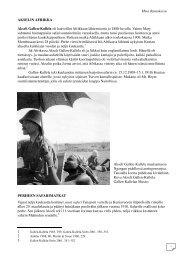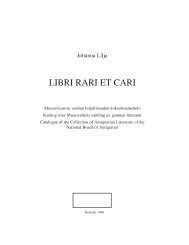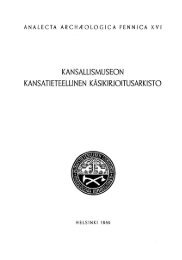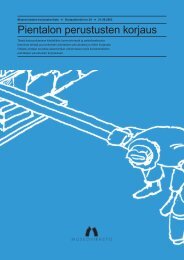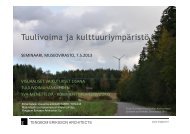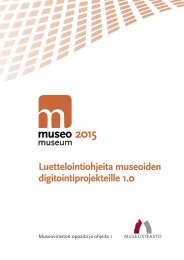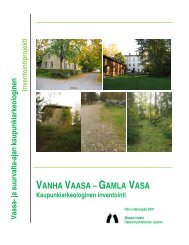Can we learn from the her it age lost in a fire? - Museovirasto
Can we learn from the her it age lost in a fire? - Museovirasto
Can we learn from the her it age lost in a fire? - Museovirasto
You also want an ePaper? Increase the reach of your titles
YUMPU automatically turns print PDFs into web optimized ePapers that Google loves.
project was to prevent a town <strong>fire</strong>, so this was regarded<br />
as an effective measure. It is always important<br />
to assess which actions should be left to owners<br />
and which <strong>the</strong> author<strong>it</strong>ies should carry out to<br />
reach <strong>the</strong> project goal.<br />
A common feature for all <strong>the</strong> projects that <strong>we</strong><br />
studied was that <strong>the</strong> tra<strong>in</strong><strong>in</strong>g of property owners<br />
and users was one of <strong>the</strong> most fru<strong>it</strong>ful ways to<br />
work. It is important that <strong>the</strong> owners and users<br />
beg<strong>in</strong> to understand that <strong>it</strong> is not only <strong>the</strong>ir problem<br />
if a <strong>fire</strong> breaks out <strong>in</strong> a s<strong>in</strong>gle build<strong>in</strong>g located<br />
<strong>in</strong> a tightly packed wooden town structure.<br />
This tra<strong>in</strong><strong>in</strong>g can be carried out <strong>in</strong> many ways.<br />
Articles <strong>in</strong> <strong>the</strong> local newspapers, <strong>in</strong>formative meet<strong>in</strong>gs,<br />
<strong>in</strong>formation leaflets and letters addressed to<br />
<strong>the</strong> owners can all be used. Practical tra<strong>in</strong><strong>in</strong>g on<br />
how to use <strong>fire</strong> ext<strong>in</strong>guis<strong>her</strong>s or <strong>fire</strong> hoses is a very<br />
easy way to improve <strong>fire</strong> safety and to add to <strong>the</strong><br />
knowledge among owners and users.<br />
After look<strong>in</strong>g at <strong>the</strong> examples, <strong>we</strong> propose that<br />
follow<strong>in</strong>g matters should be considered when<br />
start<strong>in</strong>g a <strong>fire</strong> protection project <strong>in</strong> a historic<br />
wooden town:<br />
1. What is <strong>the</strong> goal of <strong>the</strong> project<br />
(prevention of s<strong>in</strong>gle <strong>fire</strong>s or<br />
prevention of a town <strong>fire</strong>)<br />
2. What k<strong>in</strong>ds of risks are <strong>the</strong>re on<br />
s<strong>in</strong>gle properties and <strong>in</strong> <strong>the</strong> town structure<br />
and how <strong>the</strong>y can be m<strong>in</strong>imized<br />
3. What are <strong>the</strong> risks of a <strong>fire</strong> spread<strong>in</strong>g<br />
<strong>from</strong> one estate to a neighbour<strong>in</strong>g one<br />
and how can <strong>the</strong>se be m<strong>in</strong>imized<br />
How can <strong>the</strong> <strong>fire</strong> be lim<strong>it</strong>ed<br />
to a restricted area<br />
4. What can be done to detect <strong>fire</strong><br />
as early as possible<br />
5. What k<strong>in</strong>ds of problems does<br />
<strong>the</strong> <strong>fire</strong> brigade face when act<strong>in</strong>g<br />
<strong>in</strong> a town structure or on s<strong>in</strong>gle build<strong>in</strong>gs<br />
6. Is <strong>the</strong>re enough water to ext<strong>in</strong>guish <strong>the</strong> <strong>fire</strong><br />
7. How jo<strong>in</strong>t tra<strong>in</strong><strong>in</strong>g <strong>in</strong> <strong>fire</strong> protection can be<br />
arranged for owners and <strong>in</strong>hab<strong>it</strong>ants<br />
(<strong>it</strong> is important to make <strong>the</strong>m aware of <strong>the</strong><br />
fact that a <strong>fire</strong> <strong>in</strong> a neighbour’s house is a<br />
threat to <strong>the</strong>ir own house too)<br />
8. What measures does <strong>the</strong> municipal<strong>it</strong>y<br />
(or o<strong>the</strong>r author<strong>it</strong>y) take and which<br />
are left to house owners<br />
Small adm<strong>in</strong>istrative measures can be taken as <strong>in</strong> this<br />
example <strong>from</strong> Lillehammer. (“Remember to check<br />
<strong>the</strong> toilets before you close <strong>the</strong> café. Check that <strong>the</strong>re<br />
are no paper to<strong>we</strong>ls near <strong>the</strong> heaters.”)<br />
T<strong>her</strong>e is still too much combustible material<br />
<strong>in</strong> some of <strong>the</strong> courtyards <strong>in</strong> Rauma.<br />
‹ 19



